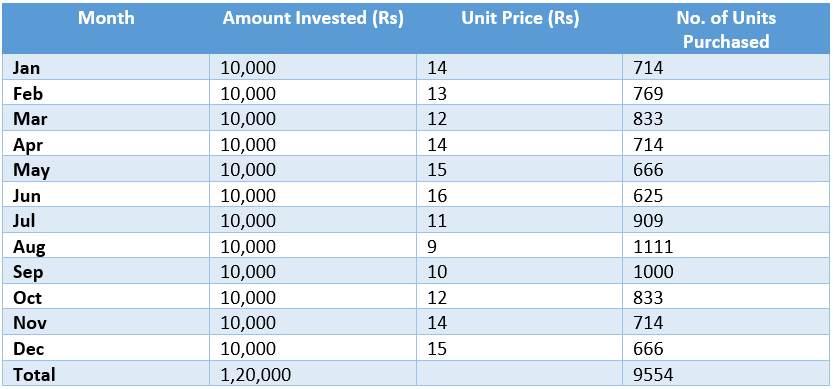Understanding Rupee Cost Averaging
By Akhil Chugh
Date July 10, 2022
“Law of demand’ is one of the fundamental concepts of economics. It states that a higher quantity of a commodity is purchased when it is least expensive. Conversely, the demand tends to reduce when the price of the commodity rises.
The fundamental principle of investing reinforces the same thing. It guides the investor to “buy-low and sell-high”. It means that you need to buy more units of an equity mutual fund when the markets are down and fewer when the markets are up. However, most of the investors end up doing just the opposite. They start buying when the markets are rising and suddenly redeem upon a slump. Ultimately, the average cost of investing increases and returns fall.

It is very difficult for investors to time the market. Rupee cost averaging works to steer away from this dilemma. In this blog, let’s understand rupee cost averaging & how it works to help investors beat the impact of market volatility on investor’s portfolios.
What is Rupee Cost Averaging?
Rupee cost averaging is a strategy to benefit from volatility in the market. With SIP, a certain amount of money is invested at regular intervals for a period of time. By investing regularly, the investor is able to invest across the market cycle (both upmarket & downmarket). For each instalment of investment, additional units of the scheme are purchased at the market rate and added to your account. A SIP investor, while investing every month, would end up buying more units when markets go down and buying fewer units when the market goes up. It would help in achieving a lower average cost per unit, thus giving the investor the benefit of rupee cost averaging.

Benefits of Rupee Cost Averaging:
- One of the best tools to generate maximum value for money invested in a volatile market scenario.
- It can be used for hedging if the market is going downward.
- Requires less effort to track the market on daily basis.
- Inculcates the habit of disciplined investments
- Provides better prospects for wealth creation
How Rupee Cost Averaging Works?
When you invest the same amount in a fund at regular intervals over time, you buy more units when the price is lower and buy less when the price is higher. Thus, you would reduce your average cost per unit over time. This strategy is termed ‘Rupee cost averaging’. With a sensible and long-term investment approach, this strategy can smooth out the market’s ups and downs and reduce the risks of investing in volatile markets.
Let’s understand this concept with the help of an illustration. Seema invests in an equity mutual fund via SIP to meet her pre-decided financial goal. She starts with a SIP of Rs 10,000 every month for a period of 1 year. Her SIP investments will look something like the below:

Over a period of 12 months, you would have invested Rs 1,20,000
- Normal Average NAV per Unit over 12 months = (Total of NAV per month/12) or Rs 12.9
- For an investment of Rs 1,20,000, you have purchased 9,554 units. So, the effective Average cost per unit is calculated as follows: Rs 120000/9554 units = Rs 12.6 (lower than the average NAV of Rs 12.9).
Therefore, the Average Cost per Unit will always be lesser than the Average NAV per unit, regardless of the market movements.
The concept of rupee cost averaging lies in averaging out the cost at which you buy units of a mutual fund. The equity markets have always been volatile reflecting the ups and downs of the economy.
In a SIP investment, the impact of volatility is reduced and as a result, the overall gains will also increase. Rupee cost averaging works out best in choppy markets.
Net Brokers Takeaways:
- Given the current scenario of the economy, the approach of averaging out the cost of investment by way of disciplined investing is fair as it will help the investor accumulate units at a cheaper rate. Doing this will enable an investor to collect sizeable wealth over the long term, given the fact that India as an economy is likely to bounce back to its growth trajectory in the long-term period of a decade.
- Rupee cost averaging works best as a long-term strategy. A SIP will leverage the benefits of rupee cost averaging in the long-term to ensure that your average cost per unit represents cycles of the market and averages out to an overall advantage.
- The benefit of rupee cost averaging in SIP allows you to invest regularly without worrying about market fluctuations. However, this doesn’t mean that you shouldn’t review your portfolio periodically. Make sure you review the performance of your investments against benchmarks, your updated goals and your risk appetite to ensure you stay on track.
As quoted by Warren Buffett, “We don’t have to be smarter than the rest. We have to be more disciplined than the rest.” It is a general perception that a bulk investment will give you better returns. But, in reality, the returns largely depend upon the discipline in investment and also its type and duration. So be disciplined and start a SIP in a mutual fund of your choice today. The Rupee cost averaging will take care of the rest.
Should you wish to know more about the benefits of rupee cost averaging, feel free to connect with our experts by dropping in a line at mail@netbrokers.co.in. To start your investment, install our Android & iOS application.
Happy SIP!



